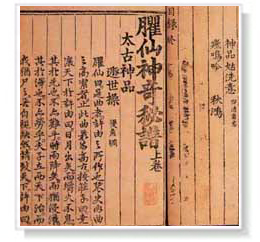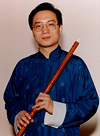
::
musicians
::
events
::
booking
::
learning
::
traditions
::
photo gallery
::
samples (audio)
::
samples (video)
::
store
::
forum
::
links
::
donation
::
contact us


Chen Tao (Director)
Melody of Dragon, Inc.
53-19 195th Street
Fresh Meadows, NY
11365
Tel: 347-259-9252
Email

|

New Music -- A Performer's Perspective
By
Chen Tao
Tone Color:
>>
Tone color is a major factor for consideration even before the
composer begins the creative process. Some composers opt for
unconventional groupings of instruments for mixed timbres. Zhou Long’s
"Su" for qin and Western flute, and his "The Ineffable" for pipa, zheng
and chamber ensemble are good examples. Faced with a new and unfamiliar
format, the performer must learn to adapt to comprehend the composer's
intent and realize it.
Traditional Chinese music embraces the natural and seeks beauty
in harmony and equilibrium. In the performance of traditional
music, fluidity, and full-bodied, unaffected, lustrous qualities
are sought, guided by the dictum, "strong but no aggressive, soft
but not weak." For the dizi, while southern style display fluid,
rounded tones and northern styles are bright and robust, the same
aesthetic principles apply. New music sets a different standard for
tone colors. Aside from resorting to traditional practices in
certain instances, new music – which calls for greater elasticity
(flexibility) –frequently exploits the extremities of tone colors.
Examples of this are the use of insubstantial tones, breath sounds,
the loud use of notes in high register, and even abnormal sounds
from the instrument. This intensification of tone colors expands the
realm of imagination and intellectual perception for the music
listener. For the performance, new music calls for a higher level of
musicianship to achieve this wide range of tone colors and elasticity.
Rhythm (Meter), Intonation and Elasticity:
>>
Compared to traditional Chinese music, new music exerts greater
demands on the performer in terms of rhythm (meter), intonation
and elasticity. Traditional music most often uses 2/4, 4/4 or 1/4
meters with relatively simple rhythmic structures and step-wise
melodic progression in keeping with the aesthetic emphasis on the
natural and gradual. To create greater contracts and elasticity, new
music composers frequently use other meters, such as 3/4, 5/8, 7/8,
5/16, 2/16 and combinations thereof, to divert the accented beat.
Some compositions even dispense with metrical markings and bar lines
entirely. Tan Dun's "Soliloquy for Dizi" and Zhou Long's work for
dizi and pipa, "Green," are compositions with complex, changing
rhythms. In ensemble works, where each instrumental line is
independent yet an integral part of the whole, each performer must
command his or her own part, and be able to sight-read from main
scores to know how it fits into the structure of the piece to
properly realize the composer's intent.
New music pieces are sometimes written in polytonal, pantonal or
atonal styles. This has brought new breakthroughs for Chinese
instruments in expression and performance techniques. Microtones
are often used to enhance the Chinese character would certainly
impose difficulties and challenges for those without formal
training.
The aforementioned elasticity (flexibility) lies at the core of
new music in regard to creation and performance (re-creation).
This elasticity is theoretically incompatible with traditional
Chinese music, which adheres to the principle of a gradual,
natural change, where variations exist within a unified whole,
and a pentatonic scale is the basis for melodic construction.
(This linearity applies to Chinese brush painting and calligraphy
as well.) Consequently, Chinese music tends toward the
harmonious, progressing step-wise; tensile strength is
uncharacteristic. New music also follow this same principle of
gradual change, but emphasizes contrasts to achieve unity of an
inner spirit. Therefore, one often finds in works of new music
large-scale intervals, conflicting rhythms and accents, varied
tone color contrasts, and deviations from traditional pentatonic
and diatonic scales. How elasticity is manifested in a musical
work and whether it bestows total freedom of expression for the
performer are a good yardstick for measuring its success. How
well a performer can crystallize this elasticity in performance
is also a measure of his or her musicianship.
Evocative Power and Expression:
>>
Subtle evocation and expression are important trademarks of
Chinese music. A good composition is said to be one, which opens
up new realms of imagination for the listener and where the
strains of the music linger on. This leads some to think that new
music, having abandoned the principles of tonal music, is unable to
produce beautiful melodies and, hence, lacks the evocative powers
and sensibilities of traditional Chinese music. There are indeed
compositions that lack sophistication and maturity, leaving the
listener bewildered and unrequited. A successful work can, however,
open up new spaces for the imagination. Through varied instrumental
combinations, rich color contrasts and tremendous flexibility, its
purpose is to suggest the abstract and invoke and impression from the
listener. Its focus is on a personal reaction from the listener and
performer as defined by the individual's level of cultivation. As a
performer, I believe that the creation of new Chinese music must also
give paramount importance to the soul of traditional Chinese music –
melody. Through the new compositions, each composer pursued the subtle,
evocative powers of music. The spiritual and esoteric qualities of Zhou
Long’s "The Ineffable," "Su," and Tan Dun's "Soliloquy for Dizi" bring
our imagination to new heithgs. Chen Yi's "As in a Dream" and Zhou
Qin-Ru's "Two Songs for Soprano and Zheng" are richly infused with the
character of Chinese folk songs. In Han Yong's "Seven Brocades,"
different percussive textures from a colorful tableau with the dizi,
erhu and zheng. This richness of sonority in most likelihood would not be
attained through traditional methods of composition and performance. Both
share a common goal – to pursue music's evocative powers – but through
different means.
The Relationship between Composer and Performer:
>>
The successful creation of new music is inseparable from the
close cooperation between a composer in command of his art and
craft and an accomplished performer. Very often a new
composition given to a performer will turn out to be different
from what the composer had envisioned, or even prove unplayable.
Another case is one that I have experienced personally. A
performer will try his hand at creating a new work, with the
belief that years of performing experience, thorough knowledge of
the repertoire and good command of performance techniques would
make this a simple task. The result is that one always goes back to
the traditional ways. One reason is a lack of professional training
in composition. Too much familiarity with one's instrument can also
be a deterrent to exploring new techniques.
For some composers, inadequate understanding of an instrument's
performance techniques or misjudging the capabilities of a
performer can affect the creation of a work. Composers are often
faced with inherent limitations of traditional instruments or of
the performers. In creating new music, the composer and performer
must work closely together. This cooperation not only refers to
composing, but also encompasses artistic preferences and aesthetic
tastes. As a result, composers' new works often spur the development
of certain instruments, while enhanced performing techniques and
increased musical vocabulary on the part of the performer create
greater possibilities for composers. The creative use of double stops
and blowing through note holes in Tan Dun's "Soliloquy for Dizi" and
unconventional tuning of the zheng in Zhou Long's "The Ineffable" are
examples of new techniques not found in traditional music.
In my initial encounters with new music more than 20 years ago,
I found myself adapting to this musical genre with some
difficulty. Looking back today, these works seem relatively
"traditional" because our horizons have broadened and performing
techniques enhanced. In this mutually beneficial relationship, the
composer should have a good command of the musical expression of
instruments while the performer should fully realize the composer's
intent. Performers must also possess depth of knowledge of
traditional Chinese music to best interpret today's new Chinese
music.
home :: email
|
|

|




explore & learn more about the Chinese music traditions.

Click here, to hear the
music samples.


meet our musicians.

copyright 2004, by melody of dragon.

|
|

